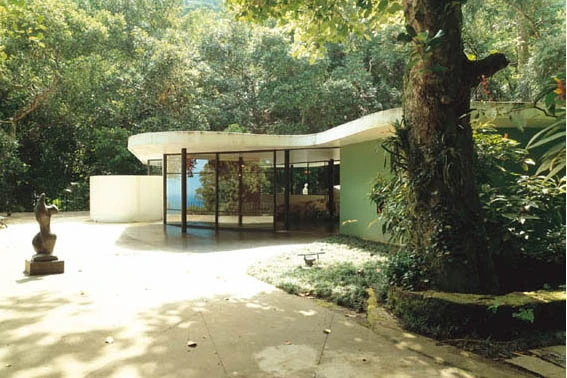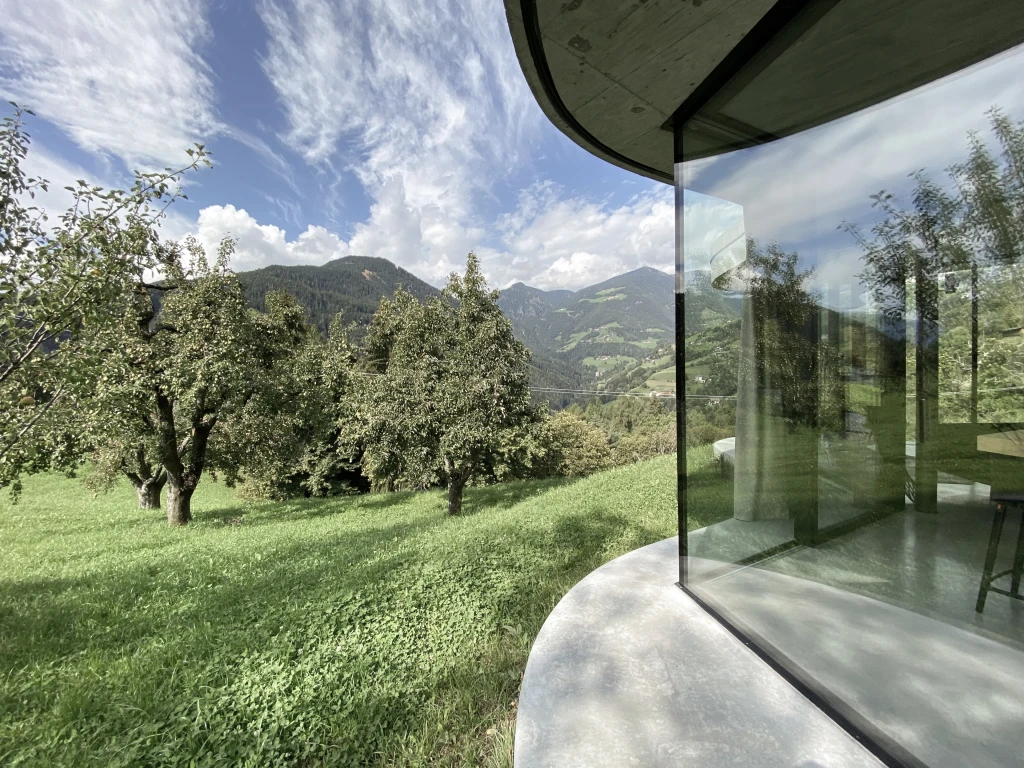Oscar & Me
The South Tyrolean architect Martin Gruber lets his thoughts fly, moves the horizon, and meets Oscar Niemeyer on the Copacabana. An ode to the creative power of the imagination.
“The new values in architecture are passion, empathy, imagination and freedom. We should love what we do. Feel the time, use it properly, inspire people and create meaning.”
~ Martin Gruber
As a child I always wanted to be a tightrope walker. I loved to balance on the curb behind our house and did this every day on the way to school while imagining a 100 meter deep abyss to the left and right. I managed to give myself a real dizzy spell with my imagination, so instead of looking at the ground while balancing, I spread my arms like wings, my gaze fixed on the horizon. That's how I felt free. On a curb.
Balance and horizon are related. Gravity acts at right angles to this. It is a permanent constant in life, especially in construction. It is what brings about the construction. Added to this are material and function, as far as the well-known parameters of archaic building. The new values in architecture are passion, empathy, imagination and freedom. We should love what we do. Feeling the time, using it properly, inspiring people and creating meaning.
My home is Verdings (South Tyrol). Living in the mountains means being more exposed to gravity than anywhere else: whether by bike or toboggan - it's either uphill or downhill. Effortlessly or almost automatically. It is thanks to gravity that the inhabitants of the mountains literally cling to every usable square meter of land. It has a strong connection to the place - maybe that's one of the reasons I kept coming back home. The story of my place and its unique horizon is about distinctiveness: the dialect, the type of people, the clouds over the village, the silhouette of the stone giants, where the sky begins.
Sport took me beyond my personal horizon: As a 14-year-old, I qualified for the European Championships in natural track luge (A luge is a small very fast sled ) in Murmansk, above the Arctic Circle in Russia, in the historic year 1989. This first big journey - I had never flown before - dissolved my previously known horizon line, gave it a different scale, a new depth. In that annus mirabilis the Soviet empire collapsed. The poverty, chaos and darkness of Russia left a lasting impression on me. I will never forget giving an orange to a boy of the same age in Kandalaksha and he started eating it with the skin on.
The rewrite
The concepts of balance and the horizon are intertwined. Gravity, a constant force in life, particularly so in construction, plays a pivotal role. Gravity is the bedrock upon which structures come to life. Building, when stripped down to its primal parameters, involves the dynamic interplay of materials and function. Yet, the ethos of modern architecture transcends the traditional confines. It pivots on values like passion, empathy, imagination, and liberty. Our labour should be a labour of love. Embracing time, making the most of it, igniting inspiration in people, and crafting significance from the ordinary.
My abode rests in Verdings, nestled within the embrace of South Tyrol's towering peaks. Here, amidst these majestic mountains, one becomes acutely aware of gravity's omnipresence. Whether navigating uphill on a bicycle or descending with almost instinctive grace on a toboggan, gravity is an ever-present companion. Inhabitants of these lofty realms treasure every square meter of land, a bond with the terrain that has lured me back time and again. The narrative of my homeland, with its distinctive horizon, weaves a tale of uniqueness — an ode to dialects, the spirit of its people, the ever-shifting clouds above the village, and the imposing silhouettes of the stone sentinels where sky kisses earth.
Sport, in its own way, broadened my horizons beyond measure. At the tender age of 14, I secured a spot in the European Championships for natural track luge, a high-speed sledding discipline. The championship took place in Murmansk, a city perched above the Arctic Circle in Russia, during the historic year of 1989. This inaugural odyssey, my maiden flight as it were, redefined the boundaries of my known world. The landscape of my perception shifted, expanded, and deepened. It was during this annus mirabilis that the Soviet empire crumbled. The poverty, chaos, and obscurity of Russia left an indelible mark on my soul. I will forever remember the moment when I offered an orange to a Russian boy of my age in Kandalaksha, only to witness him consuming it, skin and all, an act that underscored the profound disparities of our worlds.
Meeting with the master
15 years and a few medals later, I coached the Brazilian Olympic team in 4-man bobsleigh. We had qualified for the 2006 Olympic Games in Turin. So much for the plan for the winter semester. The summer, on the other hand, was reserved for my great love: architecture. Soft and sensual. Organic and confident, strong, beguiling and "unpossessible". During a bobsleigh training camp in Rio de Janeiro, I visited Niemeyer's Casa das Canoas. White concrete in the dark green jungle, curving over a rock, over a pool. Weightless and free. It was muggy, my shirt stuck to my damp skin, then the rain started. Oscar's secretary and future wife, Vera Lúcia Cabreira, watched me from the window and saw how much I was enchanted by the house. She suggested that I meet Master.
I reached the penthouse on Avenida Atlântica 3940 – with a view of the Sugar Loaf and the Copacabana – on time. Niemeyer's assistant promised me an audience of a maximum of 5 minutes. It turned into 60 minutes and we laughed a lot, because I – then in my mid-thirties – wasn't prepared for some of the 97-year-old's snappy remarks about curves. He answered my question about the importance of symmetry in his buildings with the balance of power. And indeed: construction does not lie. Anyone who stands under Niemeyer's boldly cantilevered buildings in Curitiba or Niterói will be able to sense their extraordinary constructive dimensions. Structure is balance. Mirror-image forces compensate each other, gravitation is apparently suspended. The resulting feeling of lightness and freedom shows in the most beautiful way that architecture can be the totality of proportion, material and idea.
I have a crystal clear memory of Niemeyer's argument against mental gravity, that force of habit that we can best deal with with personality and ingenuity: "Architecture consists of dream, imagination, curves and empty spaces."
Letting the world in
With this profound experience in my luggage and in my soul, I returned to Verdings, beyond the horizon that I can trace by heart. To where my grandfather gave the farm to my father and he gave it to me. I was also able to anchor the farm architecturally in the present and let the wise yesterday continue to have an effect. I studied the centuries-old building rules of the Isarco Valley - functionally proven and outgrown our mountain world - with canopy and wall service. Everything was clear, coherent and correct. But a part was missing. A part of "my" new world beyond the horizon: the salty breeze of the sea, the foreign diversity, the lightness of Brazilian modernity... The idea for a guest house came suddenly and spontaneously. My wife, who was born in Munich, and I thought ahead together. We wanted to bring the wide world to our home - friends, acquaintances, personalities. And with them interesting conversations, precious moments. Our farm is designed as a multi-generation house. We design our living space through family cohesion, appreciative interaction with people, animals and nature - embedded in an enriching, neighborly context. Architecture and nature, the rural way of life and hospitality stimulate and inspire each other on our farm. This makes the place a healing, inspiring space for relaxation and personal development for guests.
Freeform
With this in mind, and with that palette of values, I drew the freeform, designing it light and bubbly off the fly. The result is a hybrid between a guest house and a nature observatory, a walk-in spatial sculpture that only unfolded its true qualities and meditative effect after its completion. The floor and ceiling were cast in concrete in the same shape, while solid oak and loden dominate the interior. A 20 meter long glass facade encloses the organic building and it seems as if the landscape flows through it. The interior appears neutral and lacks a predetermined usage concept. This creates the freedom to locate individual needs and priorities and to consciously organize the holiday season. We only nudge the guests by omitting everything that might disturb the direct dialogue between man and nature. You will look in vain for a television in the free form, but you can look into the distance at any time of the day or night.
When I first inspected the building site, I drew structures in the air, like a conductor speaking to a string orchestra. I felt the harmony, the spirit of the place - fragile and ephemeral - immediately and absolutely. It was an attempt to touch the landscape and the building at the same time, my hand open to grasp this fleeting moment, the vision of the project. Automatically, I spread my arms, stretched them out toward beauty and longing, and for a moment it felt like I was balancing on the curb and…flying.
Author: Martin Gruber, born in 1975, is known for his striking hotel buildings and architecturally sophisticated designs. Together with his wife Anita Stare, he runs the family's organic farm and the Freiform guest house in the South Tyrolean mountain village of Verdings.
Related property: Gastehaus Freifrom











